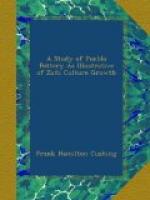As before suggested, the patterns on the coiled, regularly indented pottery (which came to be first known to the world as a type, the “corrugated,” through the earlier explorations and reports of Mr. William H. Holmes) were produced simply by emphasized indentation, more rarely by incision, and were almost invariably angular, reproducing exactly the designs on wicker work. Even in comparatively recent examples of the corrugated ware this is true; for, once connected with a type, a style of decoration, both seem to have been ever after inseparable, with at most but slight modification of the latter. One of these modifications, in both method and effect, was in the adoption of the raised or relief style of ornamentation found, with rare exceptions in the Southwest, only on corrugated ware, and on the class which in modern times has replaced it there, vessels used in cookery. Although never universal, this style deserves passing attention as the outgrowth of an effort to attain the effect of contrast produced by dyed or painted splints on wicked work before the use of paint was known in connection with pottery. The same kind of investigation indicates that the Pueblos largely owed their textile industries and designs, as well as their potter’s art, to the necessity which gave rise to the making of water-tight basketry. The terms connected with the rudimentary processes of weaving and embroidery, and the principal patterns of both (on, for example, blankets, kirtles, sacred girdles, and women’s belts), are mostly susceptible of interpretation, like the terms in pottery, as having a meaning connected with the processes of basket plaiting and painting. This renders the conventional character of Pueblo textile ornaments easy of comprehension, as well, as the very early, if not the earliest, origin of loom-weaving among our Indians in the desert regions of America.
Henceforward, then, we have only to consider decoration by painting. The probability is that this began as soon as the smooth surface in pottery was generally made; evidence of which seemingly exists; as eating bowls are, even to the present day, decorated principally on the interior; not, as may be supposed, because the exterior is more hidden from view, but because, as we have seen on a former page, bowls were made plain inside before the corrugated type formed on basket bottoms had been displaced by the smoothed type; and were naturally first decorated there with paint. It must be constantly borne in mind that a style of decoration once coupled with a kind of ware, or even a portion of a vessel, retained its association permanently.
It must have been early observed that clay of one kind, applied even thinly to the exterior of a vessel of another kind, produced, when burned, a different color. With the discovery that clays of different kinds burned in a variety of colors, to some extent irrespective of the methods and the materials used in firing, there must likewise have been hinted, we may safely conclude, the efficacy of clay washes as paint, and of paint as a decorative agent.




